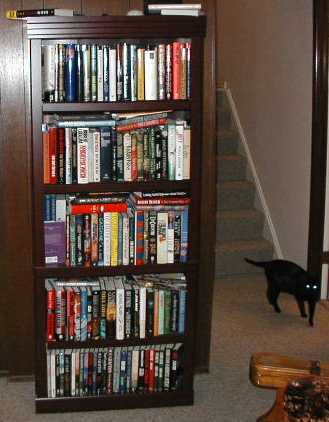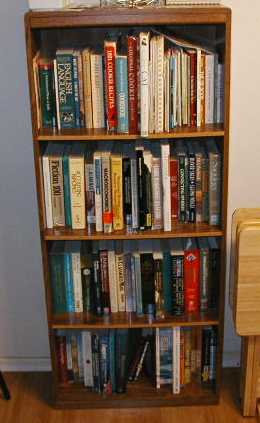Since I read a lot and nothing good seems to come of it, I’ve decided to do a bit of brief book reviewing for you, my five Internet readers. I shall incorporate some puppetry for the sixth person who cannot read but logs in for the soothing blue tones.
I have just completed We Can’t Go Home Again: An Argument about Afrocentrism by Clarence E. Walker, a professor at University of California at Davis. It’s a highly academic book, as the 31 pages (out of 164) are end notes, and it’s split into only two chapters: “If Everybody was King, Who Built the Pyramids: Afrocentrism and Black American History” (83 pages) and “‘All God’s Dangers Ain’t a White Man’ or ‘Not All Knowledge Is Power'” (50 pages). Personally, this limitation (only two chapters) rather makes it difficult to read, since the organization of the material in the macrochapters is not readily apparent (by the subdivision).
Instead, we have super-sized chapters ill-suited for consumption by a McDonald’s audience. The first chapter, “If Everybody was King, Who Built the Pyramids: Afrocentrism and Black American History”, is the pure science of the book. Walker examines certain tenets of Afrocentric thought, such as Egypt (Kemet) as the primary source for most intellectual thought in the ancient world (which the white men of Greece and Rome ripped off) and that Egypt was even a “black” culture. Instead, Walker identifies Afrocentrism as a therapeutic movement that bears little relationship to actual history. Walker also explores how black African-Americans (not redundant) in the United States diverged from Africans by the nature of their passage to this hemisphere and their bondage.
I didn’t trace the quotes nor research from his endnotes, so I cannot comment on the thoughts and arguments to which he is responding, but his historical points and interpretation make sense in themselves.
However, when we get to “‘All God’s Dangers Ain’t a White Man’ or ‘Not All Knowledge Is Power'”, Walker fails to signal for the left turn he makes. Just because Afrocentrism is wrong doesn’t mean that affirmative action should be eliminated, I think he means. He begins the second paragraph of the second chapter (page 85, remember):
A rightward drift in American politics is moving the country toward what I call “free market racism,” the state of American race relations during the last quarter of the nineteenth century, when the ideology of lassez-faire reigned supreme in the realm of economics and race on the national level.
There he lost me. Not in a violent explosion of disbelief, during which I fling the book against the wall and/or stomp on it (this wasn’t Stupid White Men, after all, and it is not a paperback). But by coining a term “free market racism,” Walker provides the good citizens of Oceania academia with a twist of logic.
Racism and affirmative action, the practice this book defends, represent a statist intrusion into thought and practice in one form or another. Free market, on the other hand, represents a rational system of commerce wherein the best value wins. In a free market of ideas, individual performance should prove a better value than racism or affirmative action. Hence, “free market racism” is a paradox, a contradiction, and a big fat hanging straw man that Walker cracks with a full swing.
I was greatly disappointed with the practical application of repudiating Afrocentrism. Quit following a foolish, bankrupt, therapeutic ideology and start supporting affirmative action. Well, the professor does teach at the University of California at Davis. What did I expect?









